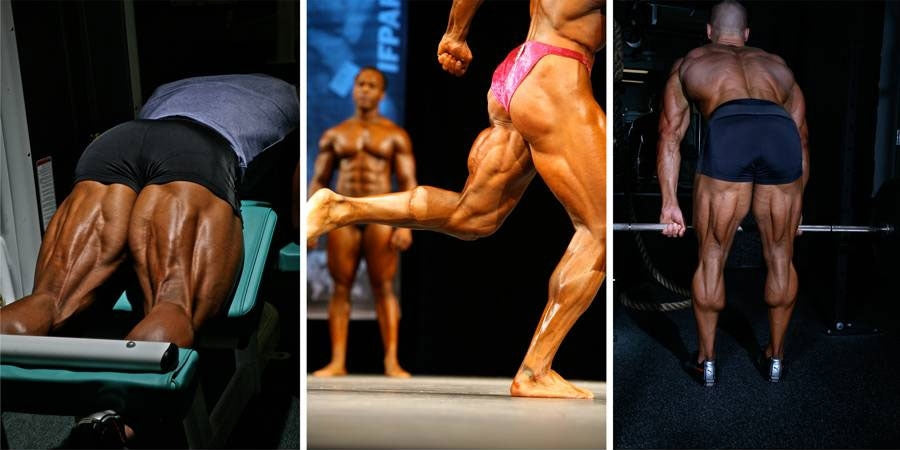
It is often said that bodybuilding shows are won or lost from the back poses. However, in addition to a wide v-taper, thickness, and “Christmas tree” detail, having great hamstrings is crucial to having a complete physique.
Separate your hamstring training from your quadriceps training.Hamstrings are a common weakness in all athletes and bodybuilders. One of the main reasons for this is that most people will train their hamstrings at the end of their leg workout. A typical workout may consist of some type of squat movement, leg press, leg extension, and then as almost an afterthought, they may throw in some leg curls. This is a huge mistake! Hamstrings are actually quite a large and very important body part not only for aesthetics on stage but also for function. (A lot of a sprinter’s speed comes from his hamstrings, not his quads). This is why in order to develop strong hamstrings, you should dedicate an entire workout just to the hamstrings (and related muscle). This type of approach would call for training “legs” twice per week. For example, you could perform a typical quad (and calf) workout on Sunday and then put a hamstring (and calf) workout on Thursday. Make sure there is adequate recover time between the quad and hamstring workouts because it is impossible to completely isolate one from the other; even if you focus on quads with squats and presses, you will also be working your hamstrings. Having a complete workout focused solely on the hamstrings will allow you to completely stimulate and fatigue the hamstring muscles with all out intensity.
Incorporate a variety of hamstring exercises that target both the hip extension (kicking the leg back) function and the knee flexion (knee bending) function of hamstrings. This is the only way to develop complete hamstrings; in other words, this is the only way to stimulate all three muscles of the hamstrings. The hamstrings consist of the semimembranosus and the semitendinosus (together referred to as the medial hamstrings) and the two-headed biceps femoris (referred to as the lateral hamstring). The medial hamstrings cross both the hip and knee joints and thus are involved in extending the hip and flexing the knee. They also assist in turning or rotating the knee inward). The long head of the biceps femoris crosses both the hip and the knee joint and is therefore involved in extending the hip and flexing the knee. The short head only crosses the knee joint, however, and therefore cannot extend the hip. Both the long and short heads of the biceps femoris help assist in turning the foot outward.
Because of the form and function of the hamstring muscles it is important to hit a variety of both “hip extension” and “knee flexion” exercises. Exercises such as Romanian deadlifts, reverse hyperextenions, and good mornings should be incorporated if hip extension function and development is lagging. The Romanian deadlift is arguably the most effective of these exercises but is often misunderstood. Most people think of the “stiff-legged” deadlift as the ideal hip extension exercise, but Romanian, or essentially “semi-stiff-legged” deadlifts, are safer and you can pull more weight. For this exercise, before bending over, make sure you chest is up, knees are slightly bent, and you have a slightly arched back with your glutes pushing backwards. As you bend at the hips keep your knees in the same slightly bent angle and keep the bar as close to your body as possible. Remember that unlike a regular deadlift, where your glutes go down, here your glutes go back, and your knee angle does not change. Although every physique is different, it is generally not necessary to lower the bar below your mid shin before reversing direction and pulling up with your hamstrings. Only go as deep as you need to feel tension on your hamstrings, but really focus on using your glutes and hams – not back or quads – to power the bar up. Romanian deadlifts can also be performed with dumbbells or a plate loaded machine.
Laying leg curl, seated leg curl, and one leg standing leg curls should also be incorporated into your routine to hit the knee flexion function of the hamstrings. There are a wide variety of curl machines and each has its pluses and minuses. No matter which curl exercises you perform, avoid using your back and jerking the weight up. Make sure you are getting a deep squeeze in the belly of the muscle. The glute ham raise is also a great exercise to target the knee flexion function of the hamstrings, but depending on how this is executed, it can actually be used to hit both functions of the hamstrings. To do this, you can use an angled hyperextenion bench. Adjust the pads so they rest low on your thighs just above the knee. Start bent at the waist and extend the hips so that your body is now straight (sort of like a back hyperextension but make sure to pull through your hams and glutes, not your back). That is the first part of the motion. Then allow your knees to drop a little below the pads and curl your body up by bending the knees. Then reverse the motions and control the eccentric part of the moves. This compound movement can also be done holding weights.
Hit exercises that target other smaller supporting and tie-in muscles.in addition to the three main hamstring muscles, your legs also consist of a number of additional muscles that assist the hamstrings in the flexing of the knee and extending of the hip. The sartorius and gracilis (and gastrocnemius) help with knee flexion while the glutes (and erector spinae) assist with hip flexion. Because having fully deleveloped, complete legs is crucial for physique athletes, it is a good idea to incorporate some compound exercises on your hamstring day that hit these supporting muscles. Exercises like the plie squat, bulgarian split squat, and walking lunges really help target the glute-ham tie-ins and will activate all the muscles of the legs. Also, don’t be afraid to use the butt blaster and adductor/abductor machines! Most men skip these exercises and most woman use these machines for aerobics! Put some weight on there and train these muscles as you would any other muscle you want to experience hypertrophy.
Putting it all together
Here are two sample workouts you could use that follow these principles. You can also incorporate calf exercises at the end of these workouts. A separate quad focused day should also be incorporated at least 3-4 days apart from these hamstring specific workouts.









